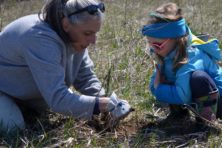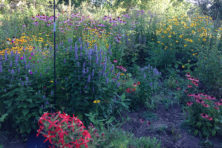Is It Time To Plant Your Garden Yet?
- Share
- Tweet
- Pin
- Share
Spring definitely tests my patience. As soon as the weather gets slightly warmer, all I want to do is start planting. However, overly large transplants or poor seed germination has definitely proved that it is best to wait.
The type of vegetable you want to grow dictates when the waiting will end. Vegetables can be loosely separated into two categories based on how well they tolerate cooler temperatures, appropriately named cool season crops and warm season crops.
Cool season crops are plants that can tolerate temperatures near freezing, the seeds typically can germinate in cooler soils and they grow best in air temperatures of 60°F to 80°F. These plants are often harvested in the early summer and can be replanted mid-summer for a fall harvest. Some examples of cool season crops are broccoli, cabbage, onions, lettuce, peas and spinach.
Warm season crops are plants that are not tolerant of cold temperatures. They require warmer soil temperatures to germinate and thrive when air temperatures are 70°F to 90°F. Examples of warm season crops include eggplants, melons, peppers, pumpkins and other winter squash, and tomatoes. (Note: winter squash is named based on the storage capacity of the fruit, not that they grow in cold temperatures.)
When determining when to start planting, there are a number of factors to consider. The first question to ask is, “When is the typical frost-free date of the area where you live?” In Door County, May 10 to 16 is usually when we see the last spring frost. Therefore, plants that can tolerate light frosts can be planted a couple weeks before this time, whereas plants that need warmer temperatures should be planted a couple weeks later. Frosts are definitely possible after mid-May, so once you have planted your garden, make sure to watch the weather forecast and be prepared to cover plants if there is a predicted frost.
The second question to ask is, “What is the soil temperature?” Temperatures that are too low for a particular plant can cause the seed to not germinate or it can lead to damping off (a root and/or stem rot) of new seedlings. Cool season crops can typically germinate at temperatures around 35°F to 40°F and warm season crops germinate at soil temperatures of 50°F to 60°F. Soil temperature readings are normally taken at 8 am (when soils are the coolest) and at four inches deep.
If you want to know the soil temperature, we are extremely fortunate to have an elaborate system of weather stations available to us. There are six weather stations in Door County located near Sister Bay, Egg Harbor, Jacksonport, Sturgeon Bay, Nasewaupee and Clay Banks. There are also two in Kewaunee County, one near Casco and the other near Stangelville. The weather stations are maintained by staff at the UW Peninsular Agricultural Research Station and data are available for free at enviroweather.msu.edu. Each weather station records information about air temperature, rainfall, soil temperature, wind speed and direction, relative humidity and more.
A third question is, “Are you going to plant seeds or transplants?” Because we have a shorter growing season, transplants can be a great way to give plants a head start. Cole crops (e.g. broccoli, Brussel sprouts, cabbage, kale) germinate best in warmer temperatures even though the plants can survive the cold. For this reason, most cole crops are started indoors 5 to 7 weeks before planting. Solenaceous crops (e.g. eggplant, pepper, tomato) are also almost always started indoors before planting. Plants in the squash family (e.g. cucumber, melons, squash) can be started indoors to give them a head start, but they have a very fragile root system and often don’t transplant well. For this reason, it is generally recommended to direct seed those plants once the soil is around 60°F rather than using transplants.
When using transplants it is critical that they are hardened off before planting. In the same way that we are not too happy when returning to a Wisconsin winter after a Florida vacation, plants that have only been in an ideal greenhouse environment are not acclimated to the outdoors. Plants can also get sunburn when first taken outside. Both these situations may accentuate transplant shock, delaying plant development and possibly leading to plant death.
To avoid issues, slowly start introducing the transplants to the outdoors. Start by placing the plants in the shade for a few hours and take them inside at night. Gradually increase the amount of time that they are outside and the amount of time that they are in the direct sunlight. After about a week, they should be ready to plant. Make sure to water them well immediately after planting.
While some years we can get away with planting earlier than normal, it is best to hedge your bets and aim for average planting dates but pay attention to air temperature and soil temperature at the time approaches. For more information about soil temperatures for specific crops, planting time, seed depth, and plant spacing, visit door.uwex.edu/horticulture or stop by the Door County Extension Office.



